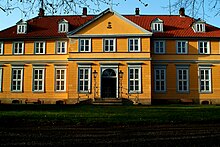Fürstenhaus Herrenhausen Museum

Copper engraving No. 16 by Joost van Sasse after Johann Julius Müller , published in 1725 by Peter Schenk the Younger in Amsterdam
The Fürstenhaus Herrenhausen-Museum in Hanover-Herrenhausen is a palace owned by the Guelph family , which was used as a museum from 1955 to 2011. The listed palace, which for a long time could also be booked for events, displayed furniture, paintings, porcelain and sculptures on the ground floor. It has been closed to the public since 2011.
Equipment (selection)
- The original decoration has been partially preserved in the building. On the vestibule in front of the central risalit there is the ceiling painting from 1721 with the depiction of Juno on clouds with a peacock and putto .
- The Fürstenhaus Herrenhausen-Museum is equipped with valuable furniture, smaller gems , sculptures , graphics and porcelain .
- The ten stately furnished living rooms include a playroom with carved furniture from the 17th century,
- as well as a seating group from Queen Marie.
- The oil paintings mainly show portraits from the 17th and 18th centuries of members of the Braunschweig-Lüneburg family as well as landscape paintings from around 1750. They mostly come from the castles in Herrenhausen , Blankenburg Castle in the Harz Mountains , the Herzberg Welfenschloss and Marienburg Castle at Pattensen .
- Culture History significant is particularly the Herzberger hunting wallpaper , a group of large-format oil paintings with the four Herzberger brothers : She came to Hanover in 1708 and it initially depended on Falk rooms of Herrenhausen Palace .
history
The half-timbered building was built in 1721 on behalf of King George I of Great Britain , who was also Elector of Braunschweig-Lüneburg . The king had the palace built for his daughter Louise von Delitz , one of three daughters who arose from the relationship between George I and his mistress Melusine Countess von der Schulenburg . The Delitzsche Palais changed hands several times in the following decades and was used by various noble families.

"In 1770 the originally nine-axis, two-storey pleasure house was expanded and provided with central projections and lower side wings". "Probably also the horticultural design of the courtyard of the U-shaped complex" dates from this time as a small baroque complex , possibly by Ernst August Charbonnier for the Chamberlain von Wallmoden . In 1836 the building came back into the possession of the crown in order to be converted into a princely guest house. 1864/65 - shortly before the end of the Kingdom of Hanover - which was façade redesigned by architect George Heinrich Schuster , who while at by Georg Ludwig Friedrich Laves conceived transformation of Herrenhausen Palace oriented: Schuster disguised half-timbered building with a yellow rustication - plastering and provided it with wooden window and door frames.
In 1866 ( annexation of the Kingdom of Hanover by Prussia ), the portrait collection of the House of Hanover was initially housed in the Princely House.
In 1936 the formerly baroque garden, which had already been converted into a kitchen garden in 1852 , was separated by the new Herrenhäuser Straße . The seat of the Evangelical Church in Germany has been located in the area of the former garden on the other side of Herrenhäuser Strasse since 1984 .
The royal house has - unlike the castle Herrenhausen - the bombing of Hannover in World War II survived. It was opened on August 13, 1955 as the Herrenhausen Museum and, after extensive renovation , was given its current name on July 10, 1985.
End as a museum
In 2011 the museum was closed for the time being. Since then, the Guelph Prince Ernst August , eldest son of the current Guelph boss , has lived in the Princely House, initially during his regular visits from London, and after his marriage in 2017 as his main residence with his family. Because of an older renovation with toxic wood preservatives, it currently has to be renovated again (2020).
literature
- Gerd Weiß: Princely House (Alte Herrenhäuser Strasse 14). In: Monument topography Federal Republic of Germany , monuments [Bd.] In Lower Saxony, Hanover, Part 1, 10.1 , ISBN 3-528-06203-7 , pp. 206f, and Herrhausen , in the system directory of the monuments gem. § 4 (NDSchG) (except for architectural monuments of the archaeological monument preservation), status July 1, 1985, City of Hanover , Lower Saxony State Administration Office - Institute for Monument Preservation , p. 15, in: Monument topography Federal Republic of Germany ...
- Fürstenhaus Herrenhausen-Museum , undated [1985], museum guide
- Hugo Thielen , Helmut Knocke : Old mansion street. In: Hannover Art and Culture Lexicon , p. 144f.
- Thomas Schwark , Waldemar R. Röhrbein : Fürstenhaus Herrenhausen Museum. In: Klaus Mlynek, Waldemar R. Röhrbein (eds.) U. a .: City Lexicon Hanover . From the beginning to the present. Schlütersche, Hannover 2009, ISBN 978-3-89993-662-9 , p. 197.
Web links
- Heinrich Prinz von Hannover : Fürstenhaus Herrenhausen-Museum , with telephone numbers to register
- Princely house in the Lower Saxony Monument Atlas
- Fürstenhaus Herrenhausen: Precious furniture, paintings, porcelain and sculptures from the property of the dukes and kings of Hanover on the hannover.de website
Individual evidence
- ^ A b Heinrich Prinz von Hannover: Fürstenhaus Herrenhausen-Museum (see web links)
- ↑ a b c d e Gerd Weiß: Fürstenhaus (Alte Herrenhäuser Strasse 14). In: Monument topography ... (see literature)
- ^ A b Stefanie Kaune: Hereditary Prince Ernst August of Hanover moves into the Princely House . Hannoversche Allgemeine from April 7, 2011. Online at www.haz.de.
- ↑ a b c d Hugo Thielen, Helmut Knocke: Alte Herrenhäuser Strasse ... (see literature)
- ↑ a b c d e f g h i j k Thomas Schwark, Waldemar R. Röhrbein: Fürstenhaus Herrenhausen Museum. In: Stadtlexikon Hannover , p. 197
Coordinates: 52 ° 23 ′ 31.5 " N , 9 ° 41 ′ 33.6" E


